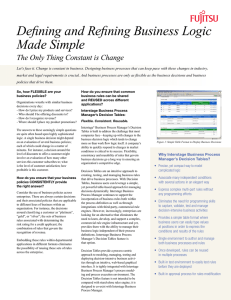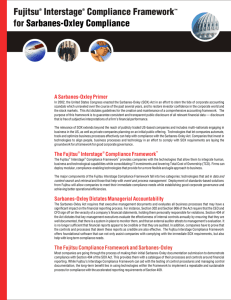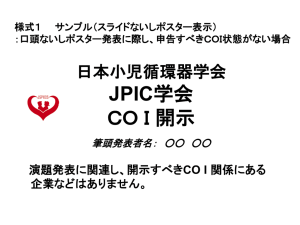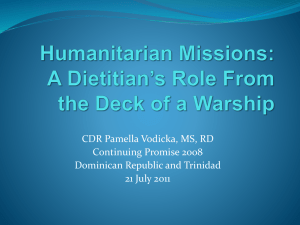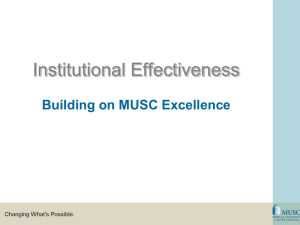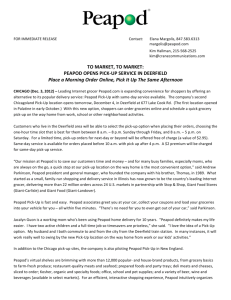Improving Interstage Growth in Single Ventricle heart
advertisement
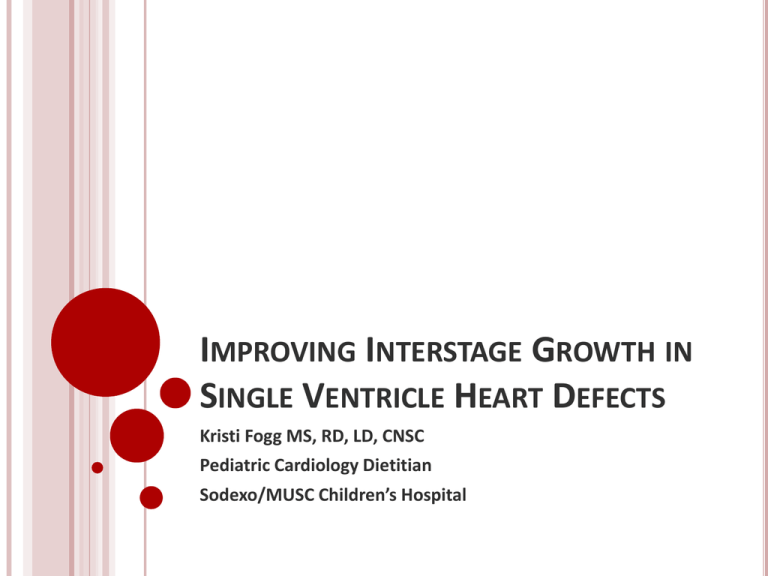
IMPROVING INTERSTAGE GROWTH IN SINGLE VENTRICLE HEART DEFECTS Kristi Fogg MS, RD, LD, CNSC Pediatric Cardiology Dietitian Sodexo/MUSC Children’s Hospital OBJECTIVES Understand factors contributing to growth failure in infants with Hypoplastic Left Heart Syndrome (HLHS) Discuss the National Pediatric Cardiology Quality Improvement Collaboration (NPC QIC) Identifying the role of the dietitian as a member of the care team Review the components of MUSC’s Interstage Growth Monitoring Pilot Program Show the role of technology in improving communication with parents and care teams ANATOMY OF THE SINGLE VENTRICLE HEART SURGICAL PATHWAY Week 1-2 of life Norwood Procedure Hybrid, central shunt 6-10 months BiDirectional Glenn 3-4 years old Fontan GROWTH FAILURE IN HLHS Poor prenatal growth (IUGR) Inability to feed preoperatively Slow progression of feedings post op Poor intestinal perfusion, NEC Reflux Oral Aversion Fluid Restriction Chromosomal abnormalities Trisomy 21, 18; Turners syndrome, Digeorge Syndrome Other non cardiac malformations Cleft lip/palate, imporforate anus, gut malrotation NATIONAL PEDIATRIC CARDIOLOGY QUALITY IMPROVEMENT COLLABORATION NPC-QIC Mission Improve care and outcomes of infants with HLHS during the 4-6 month outpatient interstage period between surgeries Improving interstage growth Reducing readmissions due to major adverse events Improving communication and care coordination with the family, referring cardiologists, and primary care clinic Includes 42 pediatric cardiology centers Physicians, CT Surgery, NP’s, Dietitians, Speech Therapists Parental Involvement NPC QIC INVOLVEMENT Learning Sessions (2x Year) Monthly Action Calls (MUSC presenting on 4 calls) Working calls focused on Growth, Care transitions, discharge planning and emerging literature PDSA Presentations Story Boards Data Entry and Data Sharing Access to shared drive LEARNING SESSION: JUNE 2012 Focus on Growth Failure Current growth trends between institutions Implementation of feeding protocols Engaging your RD Major red flag events Growth bundles Care transitions DIETITIAN INVOLVEMENT Goal: Dedicated Dietitian to Pediatric Cardiology Department to improve growth and reduce mortality Updated nutrition care plan Coordination of care w/ outlying facilities and families Phone availability when not physically present 93% Patients had dietitian available inpatient 69% had dietitian available as an OP 12% routine with clinic visit 57 % consulted as needed CURRENT SUCCESSFUL INTERVENTIONS MUSC QI IN INTERSTAGE GROWTH INTRODUCTION OF GROWTH BUNDLE Established Feeding Protocol After Hours TPN Establishing Interdisciplinary team Addition of pharmacist and dietitan Participation in rounding, care coordination, QI Non statistical significant improvement LACTOENGINEERING Hindmilk 5 minute separation of foremilk Evaluation of composite milk and hindmilk Ranging 25-33 cal/oz Eliminates need for fortification Skim Breastmilk For patients with chylous effusions Requires supplementation with MCT based formula, ADEK MVI INTERSTAGE MONITORING In the interstage, this is an extremely vulnerable time with a significant incidence of growth impairment, rehospitilization, myocardial dysfunction and death Implement an interstage growth surveillance program that performs outpatient growth, feeding, and nutrition monitoring between Norwood and Glenn surgery. Develop and promote an interprofessional collaboration to reduce interstage growth failure INTERSTAGE MONITORING PROGRAM IP Grant ($15,000) Fosters an environment that rewards innovative and integrated education, research and patient care. Scales, Pulse ox monitors, educational binders, Learning sessions for NPC, Peapod maintenance Why is MUSC unique? NO ONE is excluded Technology Interaction with outlying facilities Funding INCLUSION CRITERIA Neonates requiring surgical shunt placement, PA banding, Norwood procedure, or hybrid procedure for single ventricle anatomy Once transferred to the stepdown unit, parents are consented and education is initiated Discharge Teaching Started Discharge Educational Binder Use of Pulse Ox, Infant Scale Formula Preparation Red Flag Action Plan Use of Google Voice Correspondence Peapod Measurement PEAPOD MEASUREMENT Body Mass Measurement Measured oxygen consumption, CO2 expelled, BSA Infants and Body Mass Long term correlation with chronic disease Possible use in anesthesia Leaner babies have higher BMR Correlation in Cardiac Babies? PEAPOD MEASUREMENT WEIGHT MONITORING AND SAT MONITORING Decrease interstage mortality Earlier feeding interventions Triaging red flag action plans Improved detection of important residual/recurrent lesions and improved survival Avoiding unnecessary ER visits Earlier operative intervention RED ACTION PLAN O2 Saturations ≥ 90% ≥ 70% and < 90% Continue current therapy NO - Respiratory distress? - Decreasing PO intake or increasing fatigue? - Changes in skin color or perfusion? - Poor weight gain? < 70% YES -Medical evaluation Inadequate Weight Gain Less than 20 gram weight gain over 3 days 30 gram weight loss in 24 hours Has achieved goal calories of 110-150 cal/kg/day Signs of acute illness present YES - Is formula preparation correct? - Are weights being properly performed? NO - Signs of aspiration? - Respiratory distress? - Weak cry? - Emesis? - Diarrhea? - Bloody stools? - Decreasing PO intake or increasing fatigue? - Changes in skin color or perfusion? NO YES - Review feeding regimen - Review formula recipe/mixing - Daily weight reporting until consistent weight gain x 3 days NO NO - Increase volume of feedings OR increase caloric density - Daily weight reporting until consistent weight gain x 3 days YES YES - Medical evaluation - Possible inpatient admission USE OF TECHNOLOGY Parents communicate daily using google voice Text/Call to adjust feedings or address red action plan Data entered into shared drive Weekly Rounding BiMonthly progress report to pediatrician and cardiologist GOOGLE VOICE FOR PARENTAL COMMUNICATION Free! Need Google account Assigned local number Texting/Voicemail Voicemail Transcription Able to re-route to multiple phones Allow on call schedule GOOGLE VOICE date growth x 7d sat weight 1-Aug 4.51 27 growth regimen 75 ml over 1hr, Alimentum 27 cal/oz. Going up 1ml at a time, every 86few days. Takes up to 55 ml at TID feeds 2-Aug 4.5 21 81 3-Aug 4.51 20 84 4-Aug 4.53 20 85 5-Aug 4.55 10 88119 cal/kg/day 6-Aug 4.59 16 85 7-Aug 4.62 18 83 8-Aug 4.67 23 81 9-Aug 10Aug 11Aug 12Aug 13Aug 4.69 27 88 4.71 29 85 4.73 29 84 4.73 26 81 90 21 @ 77 ml q 3hr, added olive oil, 81giving 130 cal/kg 88 4.74 weight 4.8 4.75 4.7 4.65 4.6 4.55 4.5 4.45 4.4 4.35 weight 1 2 3 4 5 6 7 8 9 10 11 12 13 sat 86 84 sat 82 80 78 76 1 2 3 4 5 6 7 8 9 10 11 12 13 THANK YOU! QUESTIONS????
